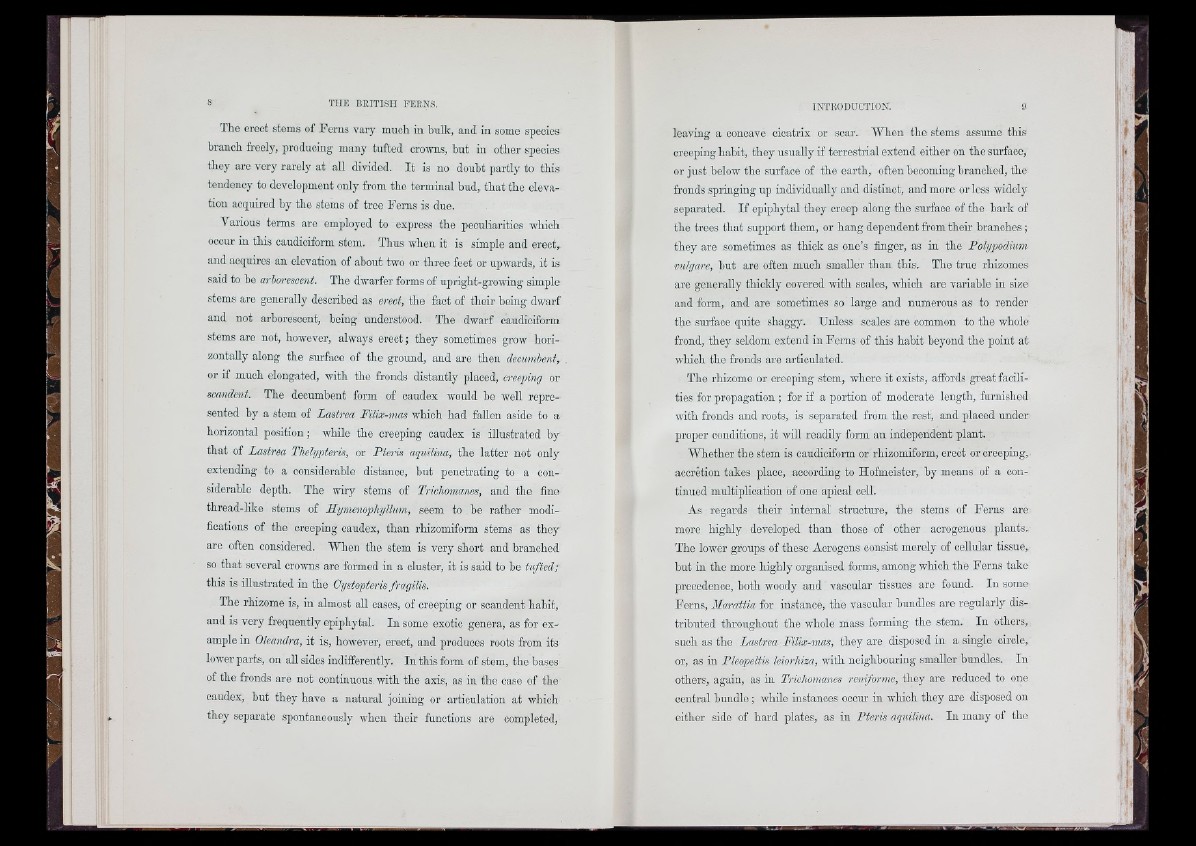
The erect stems of Ferns vary much in bullc, and in some species
branch freely, producing many tufted crowns, but iu other species
tliey are very rarely at all divided. I t is no doubt partly to this
tendency to development only from tho terminal hud, th a t the oleva-
tiou acquired by the stems of tree Ferns is due.
Various terms are employed to express the peculiarities which
occur in this caudiciform stem. Thus when it is simple and erect,
and acquires an elevation of about two or three feet or upwards, it is
said to ho arborescent. The dwarfer forms of upright-growing simple
•stems are generally described as erect, the fact of thoir being dwarf
and not arborescent, being understood. The dwarf caudiciform
stems aro not, however, always erect ; they sometimes grow horizontally
along the surface of the ground, and are then decumbent,
or if much elongated, with the fronds distantly placed, creeping or
scandent. The decumbent form of caudex would be well represented
by a stem of Lastrea Filix-mas which had fallen aside to a
horizontal position ; while the creeping caudex is illustrated by
that of Lastrea Thelypteris, or Pteris aquiUna, the latter not only
extending to a considerable distance, hut penetrating to a considerable
depth. The wiry stems of Trichomams, and the fine
thread-like stems of HymenophyUum, seem to be rather modifications
of the creeping caudex, than rhizomiform stems as they
are often considered. When the stem is very short and branched
so that several crowns are formed in a cluster, it is said to be tufted;
this is illustrated in tho Cystopteris fragilis.
The rhizome is, in almost all oases, of creeping or scandent habit,
and is very frequently epiphytal. In some exotic genera, as for example
in Oleandra, it is, however, erect, and produces roots from its
lower parts, on all sides indifferently. In this form of stem, the bases
of the fronds are not continuous with the axis, as in the case of the
caudex, but they have a natural joining or articulation at which
they separate spontaneously when their functions are completed.
leaving a concave cicatrix or soar. When the stems assume this
creeping habit, they usually if terrestrial extend either on tho surface,
or just below the surface of the earth, often boooming branched, the
fronds springing up individually and distinct, and moro or less widely
separated. I f epiphytal they creep along the surface of the hark of
the trees that support them, or hang dependent from thoir branches ;
they aro sometimes as thick as one’s finger, as in the Polypodium
mlgare, hut aro often much smaller than this. The true rhizomes
are generally thickly covered with scales, which are variable in size
and form, and aro sometimes so large and numerous as to render
the surface quite shaggy. Unless scales are common to the whole
frond, they seldom extend in Ferns of this habit beyond tho point at
which the fronds are articulated.
The rhizome or creeping stem, where it exists, affords great facilities
for propagation ; for if a portion of moderate length, furnished
with fronds and roots, is separated from tho rest, and placed under
proper conditions, it will readily form an independent plant.
Whether tho stem is caudiciform or rhizomiform, erect or creeping,
accretion takes place, according to Ilofmeister, by means of a continued
multiplication of one apical coll.
As regards thoir internal structure, the stems of Ferns arc
more highly developed than those of other acrogenous plants.
The lower groups of these Acrogens consist merely of cellular tissue,
but in the more highly organised forms, among which the Ferns take
precedence, both woody and vascular tissues are found. In some
Ferns, Marattia for instance, the vascular bundles arc regularly distributed
throughout tho whole mass forming the stem. In others,
such as the Lastrea Filix-mas, they are disposed in a single circle,
or, as in Pkopeltis leiorhiza, with neighbouring smaller bundles. In
others, again, as in Trichonumes reniforme, they are reduced to one
central bundle; while instances occur in which they are disposed on
either side of hard plates, as in Pteris aquilina. In many of tho
!»
Ifi